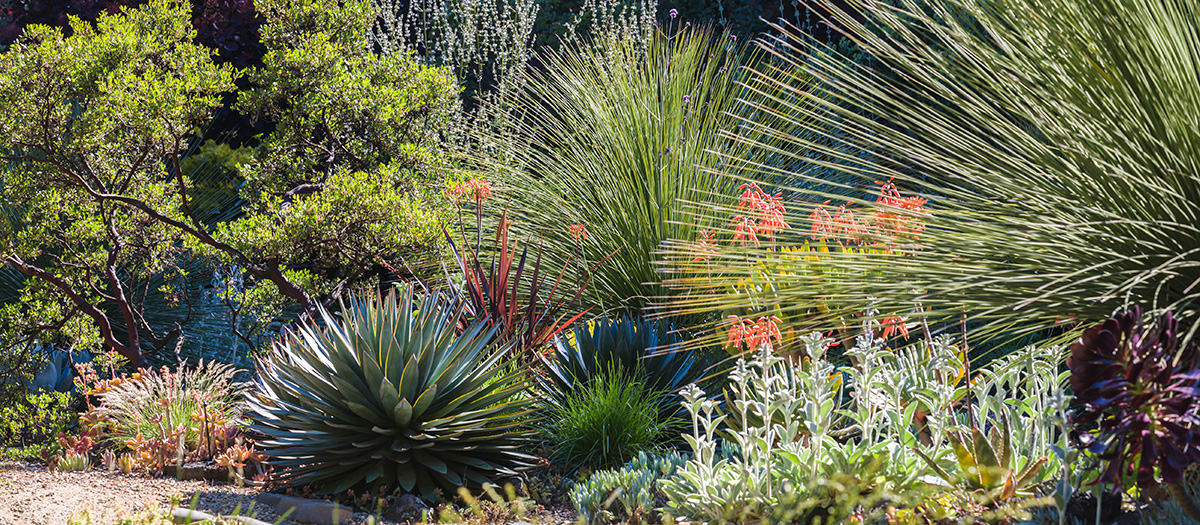With approximately 60 percent of Southern Nevada's water used outdoors, it's important to ensure you're managing your outdoor water use efficiently. Learn how to keep your landscape healthy, while keeping your water use to a minimum.
Chat with us
Questions about which days you can water? Chat with us for quick answers.
Warm weather tips
Don't crank up your landscape watering as soon as temperatures get warmer—in early spring, grass, trees and plants don't need as much water as we tend to think. In March and April, gradually increase your watering schedule from one to three days as temperatures warrant.
Brown spots
- Hand water brown spots until they are gone.
- Eliminate blocked spray patterns by trimming around the sprinkler head or installing a taller 3- or 4-inch pop-up.
- Make sure you are using the same type of sprinkler heads throughout your lawn, do not mix and match.
- Check that your sprinkler heads are level to grade, perpendicular to the slope of the lawn and not watering sidewalks, walls, or patios.
- Ensure sprinkler heads provide "head-to-head" coverage. The spray of one sprinkler should reach the head of the adjacent sprinkler.
- Determine whether water pressure is a factor. Misting and excessive drift are signs of high pressure. Low pressure displays itself with weak, short spray patterns and reduced coverage.
Burned and scorched leaves
- Water plants deeply and infrequently to allow oxygen in the soil, wash away salts, and encourage deep rooting.
- Deeply water trees and shrubs once every seven to 10 days. Newer plants may need water twice as often.
- Add a layer of surface mulch 2- to 4-inches thick to conserve water and provide insulation from the heat.
- Ensure you are using the right fertilizer both for your specific plants and for the time of year. Some fertilizers release much faster in hot weather, increasing the potential for damage.
Compacted soils
- Aerate at least twice a year to minimize compacted soils, which can stress your lawn.
- If you notice an area that is particularly dry, add a tablespoon of liquid soap to a gallon of water and drench the dried area. This breaks down the surface tension of the grass.
Grass
Each time you mow the lawn, change directions and set your mower to the proper height (2 ½ - 3 inches for tall fescue and ¾ - 1 ½ inches for Bermuda) to promote a healthy lawn and to reduce water use.
When to water
- Water overnight or around dawn to minimize the amount of water lost to evaporation. For example. 5, 6, and 7 a.m. And remember to add watering days gradually as temperatures get hotter. Start with three to four days in May, then increase watering days to five or six as needed in June, July and August.
- Use these drip irrigation tips and sprinkler irrigation tips to get the most from your water.
Plant selection
Choose native plants that are meant for the arid Southern Nevada climate and require less water and maintenance. There are a variety of low-maintenance plants which will add both color and vibrance to your landscape. Bermuda and other warm-season grasses require about one-third less water than tall fescue grass.
Year-round tips
- Use a drip irrigation system to water trees and shrubs and water appropriately. Experts agree that running drip irrigation less frequently is much better for plants than daily watering.
- Fine tune watering times for each station to account for different watering requirements due to exposure, shade, and sprinkler output.
- Adjust your irrigation clock seasonally and comply with mandatory watering restrictions. Consider upgrading to a smart irrigation clock, if you haven't already.
- Check your sprinkler system once a week. Replace or repair broken or missing sprinklers.
- Once a month, check your drip irrigation system for breaks or clogs.
- Arrange sprinklers so that the spray of one sprinkler reaches the head of the sprinkler closest to it. Remove any obstructions and level sprinklers to grade to prevent spray blockage or tripping hazards. Ensure sprinklers aren't spraying walls, driveways, or sidewalks.
- Water shady areas about 30 percent less than sunny areas.
